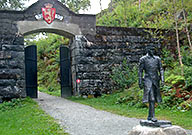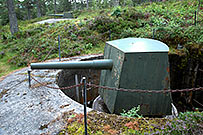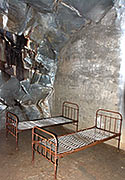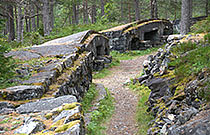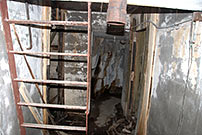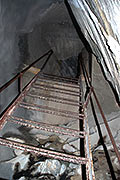Fortress Hegra
In Norway, the name sounds the same as in Russia - Stalingrad, ie as a symbol of bravery and courage. In April-May 1940 this tiny mountain fortress with a garrison of 250 people resisted reflect the attack of many times superior enemy forces nearly a month. The history of the fortress takes its origin in the beginning of the XX century.
After breaking the union with Sweden in 1905 Norway begun to work on its border protection. Revanchists in Sweden run strong campaign for the war. War did not happen, but some measures have been taken by the Norwegian government.
In 1908-1910 the artillery fort was built to the east of Trondheim in the Stjørdal river valley on Ingstadklieven Hill with the task of blocking the way to Trøndelag from the east, from Sweden. Reconnaissance of the construction site was made back in 1906, however, the Storting has allocated needed money only in May 1908. The fortress was called Fort Ingstadklieva, although later it became known by the name of the nearby village of Hegra.
Ingstadklieven Mountain rises up to 250 m above the valley of the river Stjørdal and it offers a great overview to the east, but in the west sector of fire is limited. Gun positions on the top of the mountain were surrounded by underground shelters and gunpowder cellars and cut into the rock trenches, positions for field guns and barbed wire.
Fortress artillery consisted of two 75-mm and four 105-mm guns and four 84 mm field guns. Until 1926 Hegra fortress was in ranks and protected the eastern borders of the Norwegian state, but then it was put in reserve because of the reduction of the Norway military budget.
In 1934 the fortress was deactivated and handed over to the Norwegian Red Cross for youth summer camp. Late 1939 there was an internment camp for Finnish soldiers from Lapland army group, who retreated to Finnmark soon after fighting with Soviets in Petsamo.
April 9, 1940, Nazi Germany without declaration of war invaded Norway. During the mobilization reservists-gunners began arriving in to a military camp near Værnes airport, north of Trondheim at the disposal of the commander of the 3rd Artillery Regiment, Major Hans Holtermann.
Because of the rapid advance of the Germans, Holterman evacuated some of his people in the Hegra fortress. April 11 the Germans captured the Værnes base, but with the assistance of local residents, Holterman managed to took out a large amount of equipment and ammunition to Hegra. Here April 13, he was ordered to continue to mobilization and try to prevent the Germans to control railway in Sweden. He had a garrison of 50 artillerymen, 200 volunteers from local residents and one woman nurse.
Since April 14, the fortress became subject of regular Germans bombing and shelling. Norwegians initially opposed to the Jaegers of the 3rd Mountain Division (1st Battalion, 138 Regiment). On April 17, Germans made their first attack on the fortress but were repulsed with considerable loss. A day later they repeated the attempt with the same result. April 25 mountain Jaegers were replaced with German 181 Infantry division and the ruthless siege began, accompanied by shelling, bombings and fierce clashes of reconnaissance squads.
Hegra Fortress fought until there was a hope on the Allied offensive from the area of Narvik, but that hope began to melt since May 2. Allies left Åndalsnes area south of Trondheim, Norway's 4th Brigade ceased to resist in West Norway, food reserves in a fortress come to end. May 3, the garrison began the destruction of weapons and ammunition and 5 May the fortress was surrended.
Total losses of defenders of the Hegra were 6 KIA (all in the fight for Hegra railway station) and 15 wounded. The Germans lost more than 200 KIA and WIA, and one of the prisoners. During the fighting, a German plane was shot down and another was damaged.
With the end of World War II and to this day, Hegra fortress is under the control of the Norwegian Army. The Norwegian Ministry of Defense funded the fortress museum and all its activities. Since 1962, the rifle club Hegra in May hosts the annual competition for sports shooting. There is a café and a souvenir shop near the fortress.
Impressions
I've been there in late August, in a non-tourist season. It was Scandinavian quiet fall, in the east of upon the Sweden silent flashes of last in this year thunderstorm were seen. In the morning, train three dozen mountaineers with weighty backpacks - vacation. I went out alone at the Hegra station.
From the station by a winding mountain road up to the fortress. A cup of coffee at a shop at the entrance to the fortress, the traditional T-shirt with 'Hegra 1940' - all it inscribed on the memory. 'Herr tourist needs a guide?' - 'No, thanks, I know what to do...'
Well, the fortress is in my full disposal for the whole day ... There are no visitors except for me in echoing caves, passages, stairs, tunnels ... Trenches, gun positions, the ruins in the wood, rusty barbed wire ... The characteristic smell of war dungeons ... And, as always in these places - a keen sense of the historicity of the place.
Here I'm writing this text a long time later, but the impression of freshness alive still...
On my way back, I tried to go down the northern slope of the mountain. Do not do this foolishness...
If you go over the bridge across the river in Hegra village, you can find and visit for free a small, but very informative local history museum. They have an especially impressive mannequin depicting a frozen to death, a Swedish soldier. The exhibition tells about the famous 'death march' of the Swedish army of K. Armfelt in 1718. But that's another story...
Land forts and fortress:
Bip Castle Gatchina Ivangorod Izborsk Kexholm Kirillov Monastery Koporye Novgorod Pechorskiy Monastery Peter&Paul Fortress Porkhov Pskov Schlisselburg Staraya Ladoga Tikhvin Vyborg Hameenlinna Hamina Kastelholm Kymenlinna Lappaenranta Raseborg Castle Savonlinna Tavetti Turku Visby Fredrikstadt Fredriksten Hegra Fort Hoytorp Fort Arensburg Narva Tallinn Antipatris Caesarea Jerusalem Latrun Fort Masada
Sea forts and fortresses:
Alexander Fort Ino Fort Krasnaya Gorka Fort Kronstadt: Kotlin isl. Kronstadt: North Forts Kronstadt: South Forts Trongsund Hanko Svartholm Sveaborg Marstrand Siaro Fort Vaxholm Oscarsborg
Artillery batteries and individual guns:
Coastal Artillery Hemso Fort
Fortified areas and defensive lines:
Karelian Fortified Area (KaUR) KrUR Leningrad Mannerheim Line Nevsky Bridgehead VT Line Harparskog Line Salpa Line Gothland
Russian
S e a r c h All news

